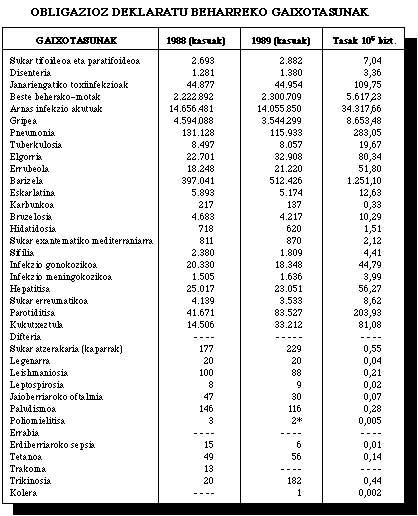Viral diseases during pregnancy
1992/09/01 Txueka Isasti, Fernando Iturria: Elhuyar aldizkaria
Viral infection to reach the fetus during pregnancy is necessary to spread the placenta. There are still no known viruses that contaminate the placenta by fetal contagion. The most well-known episodes that can cause infections at the beginning of pregnancy are common abortion and teratogenicity. Common miscarriage is due to painful placenta, vascular modification of the endometrium, or primary death of the fetus. To a large extent, the mother's systemic infection, known as viremia, or treatments are the cause of many childhood losses and not viral infection that can directly affect the fetus. When pregnancy progresses, fetal infection can lead to special complications, such as cell destruction and the resulting imbalance and stopping child growth.
Ways of infection
In the potential advancement of the fetus are many mechanisms of infection. Some are known and well certified, others rare or theoretically proposed. In viral infections that occur in the generation zone, it is shown to occur in the early stages of embryogenesis.
Ascending Path

The best known path in intrauterine infections is the so-called "ascending path". This pathway is rare in viral infections of the clinical manifestation. So far the Herpes simplex is the only one that is shown to infect the placenta and the amniotic sac by this way. This does not mean that other types of viruses do not make this way.
Intrabaginal and cervical microorganisms reach the fetus by colonizing membranes and anmiotic sacs through the cervix.
Upstream contamination can be accelerated by breakage of the membrane crust or by manipulation, such as vaginal touch. Although the membranes are complete, it is clear that an infection can occur. Although rarely in the realization of amniocentesis can occur by instrumental manipulation.
Being an infected amniotic sac, the fetus injects contaminated liquid and can cause pneumonia at birth.
If the vagina is colonized, the child becomes infected with childbirth and has a perinatal viral infection.
Hematogen Hematogen
Hematogenous infection is associated with maternal reemia. The virus goes into the blood of the mother. Microorganisms reach the blood vessels and interbeautiful moments of the endometrium from the blood of the mother and from here contaminate the placenta to the fetus.
If microorganisms spread in the child's blood, a systemic infection occurs and wounds can be found in the organs.
If infection occurs inside the placenta, inflammatory lesions called billositis appear in the bellosity of the crown. Billositis represents a lot of pathological changes; necrosis and trophoblast fibrosis. Therefore, at the end of the inflammatory process, the bellosities of the placenta could be atrophied. The degree of involvement of billositis depends on the atrophy that is spread in the square.
Rubéola rubella (Rubella)
Currently, the general vaccination of women makes it difficult to find a congenital rubella in the fetus. But due to the effect that this special disease has had, it is well known how it causes damage to the child.
During the epidemic, it has been observed that at the beginning of the infection the placenta was contaminated.
Rubella is a special disease that contaminates the fetus and placenta of the maternal blood.
The Togabantivirus RNA virus that generates is of a single thread and has an incubation period of 14 to 21 days, dispersing through the channel in the drops of nasopharyngeal secretions.
The prodrom could last five days. Lymphadenopathy after general discomfort, fever, burukomin, conjunctivitis and pharyngitis. Then the well-known maculo-papular exanthemas. The latter could last almost three days. Between 60% and 70% of those affected suffer asymptomatic infection.
This virus has great importance for its potential teratogenic effect. Immediately after primary maternal infection, intrauterine transmission occurs. In the child the infection can occur at the time of creation. In the first 12 weeks of pregnancy 80% can have infected the fetus, between week 13 and 14 54% and week 22 25%. It is rare that the mother infects the fetus because she has had rubella from week 22.
The infection causes the fetus a syndrome called congenital rubella during the first 8 weeks of gestation. After this period the wounds are minor and can only occur in special organs. Thus, in the first quarter almost 22% are recorded congenital malformations and in the second quarter only 0%.
The clinical manifestations of the rubella congenital are very broad. The classic triad is formed by the cataract of the eyes, deafness and congenital heart disease of the heart.
In newborns, not all changes of character related to congenital rubella are perceived. Deafness, for example, is not diagnosed until the end of breastfeeding.
33% of newborns with congenital syndrome have the disease silently at birth, but as the growth progresses they are presented with an error.
The rubella virus at the cellular level acts by different mechanisms to produce wounds to the fetus. The disease can cause necrosis and cell death. Vasculitis and ischemia alter cell growth in the organs and reduce the capacity of the affected organs. The latest research relates rubella to the modification of chromosomes and it has been shown that the detection of cell mitosis can cause changes in tissue growth.
The persistence of the viruses in the cells causes antigenemia, thus involving the autoimmunization system, such as endocrine diseases.
Cytomegalovirus (CMV-ZMB)
The DNA distributed throughout the world is the Herpes virus of double thread.
The infection is not perceived clinically. Sometimes it appears as a mononucleosis infection. Studies indicate that 57% of women in fertilisation age are seropositive to cytomegalovirus and 14% say there is virus excretion in the utero fence.
Cytomegalovirus is the viral infection that most contaminates the baby during pregnancy. Incidence in 1% of newborns.
It is believed that the pathogenesis of this virus is similar to rubella, that is, that the infection in the mother produces a viremia and the placenta is transmitted to the child. Spreading the placenta like rubella does not mean that the child is always contaminated. An upstream infection is possible, but it is not common.
Unlike other viral infections, the presence of cytomegalovirus antibodies does not prevent it from becoming infected again, the virus that is found in the lethargy may be activated.
The frequency of congenital infection during pregnancy is related to the time when the virus is transmitted. In the first two quarters, the frequency of infection is lower than in the third quarter.
Congenital defects due to cytomegalovirus are very broad, especially in the central nervous system and in the visual ear. However, in infected newborns, 90% have no clinical explanation of the disease.
5% have cytomegalovirus pathology: hepatoesplenomelagia, thrombocytopenia, mental retardation, coriorretinitis, pneumonitis and growth delay.
5% of the rest of newborns indicates the atypical expression of the disease, with neurological and psychomotor disorders at different levels.
ZMB produces a cell wound, directly or indirectly, by cytosis. Cyolysis is the evolution of destructive immune reaction. On the other hand, it has been observed that in textile cultures the virus can last for a long time without producing cytopathic alterations.
The cell wound occurs in indirect mechanisms with secondary inflammatory responses and through vasculitis. Vasculitis due to ischemia and tissue rupture. Infected newborns carry immune complexes in blood and in this disease it is shown that these complexes are intermediaries.
Common herpes virus (HBV)
Simple herpes viruses are very varied and can cause infection at different levels. Herpes genital virus is associated with the so-called 11 mold. In the United States, between 5 and 10 million genital herpes are seen each year and the number increases year after year.
This virus has the ability to accelerate or wake up periodically after basic infection. When almost all herpes infections occur during pregnancy, the disease indicates that the virus in the lethargy has been awakened.
It is due to herpes infection that occurs in infants when delivery. In the first half of pregnancy there is common miscarriage, intrauterine death, and congenital infections as a result of basic herpes virus infection. The incidence of herpes in generalized infection during pregnancy is not yet known, but it is considered sporadic.
The only cases of congenital malformation related to herpes virus are those that occurred in the first trimester of pregnancy.
The herpes virus can cause a general infection of the fetus through the placenta, causing the child's intrauterine death. In the live newborn, morbidity is around 40% and the neurological consequences would be long.
Epstein-Barr virus (EB)
Most adults are seropositive. It is therefore difficult to find seronegative in pregnant women and even more difficult to develop a basic infection caused by the Epstein-Barr virus.
The research carried out in a group of 46 seronegative women revealed that 7% of the cases had positive seroconversion. Although this is not reliable, other researchers have not known in their work a high rate of seroconversion.
In some simple studies, it has been possible to observe the relationship between congenital malformation and virological and serological dates in EU infections.
The anomalies introduced in CVR infections are congenital heart diseases, malformations or abnormalities of the Central Nervous System, cataracts, biliary atresia, microophthalmic, metafisitis and low birth weight.
Barizela-Zoster virus (VZV)
Herpes virus DNA is the creator of the zoster chickenpox. Being a childhood infection, the majority of the population is seropositive. In children it is called clinically varicella. Later in adults, with the virus in lethargy, it is stimulated over time and leads to herpes zoster disease, another clinical entity.
Chickenpox is a contagious respiratory infection that stands out for skin wounds. The incubation period is approximately 14-16 days. After the biremia appear fever, restlessness and spicy skin balloons. The exanthema lasts between 7 and 10 days. The zoster infection during pregnancy is very rare, with only 0.5 cases of 10,000 pregnancies. On the other hand, 95% of potentially pregnant women are hiv-positive. Therefore, the incidence of chickenpox during pregnancy is only 7 out of 10,000 pregnancies.
If chickenpox infection occurs in the first half of pregnancy, it is related to the birth defects seen in newborn children. The incidence of neonatal chickenpox in the last three weeks of pregnancy is 25%.
The known clinical manifestations of congenital varicella are:
- neurological: microophthalmic, cerebellar atrophy and focal cerebral calcification.
- visual: coriorrhinitis, microoptamia, optic nerve atrophy.
- superficial: scar wounds.
- Muscle skeletal: muscle atrophy, hypoplasia of arms and legs.
- Intrauterine growth retardation (ICR).
In animals and people who have experienced chickenpox, it has been shown that in blood leukocytes this virus could cause chromosomal abnormalities.
The children of women who have suffered chickenpox during pregnancy are at risk for leukemia, although it has not been accurately measured.
Enterobirus

They are RNA virus. Polio viruses, A koxsackie, B koxsackie and ECHO are called enterovirus. In children and low socioeconomic groups, enterobirus infections frequently occur.
Clinical manifestations of infection are different among patients. It can be asymptomatic or fever infection and high breathing. Others present more serious clinical manifestations such as poliomyelitis, meningoencephalitis or pleurodimia.
In experimental work with animals during pregnancy, it has been observed that the incubation of enterobirus is short, a faster viremia in the mother and a greater sensitivity to infection.
Although most infections are asymptomatic during pregnancy, the common abortion rate may vary between 13% and 24% if the pregnancy is complicated with polio and Al6 koxsackie infections. ECHO virus and B koxsackie infections are associated with infant deaths during pregnancy. Other reports indicate the relationship between pregnancy and urological abnormalities and cardiac malformations B3 and B4 coxsackie of the ECHO virus. The malformations of the digestive system, on the other hand, relate A9 to coxsackieres. The levels of this malformation are usually very different and unspecific.
It is considered that the infectious transmission of the mother to the child occurs through the squares, which is known as transplacental.
Influenza Influenza Influenza Influenza Influenza Influenza Influenza Influenza Influenza Influenza Influenza Influenza Influenza Influenza Influenza Influenza Influenza Influenza Influenza
Influenza is a frequent viral infection during pregnancy, especially in epidemic times. The effect of this virus on the fetus is little known and its ability to teratogenicity is still unsolved. Influenza virus produces acute respiratory infection and generalized instability. In principle, clinical symptomatology is not sufficient to ensure diagnosis, since serological research is necessary to carry out a complete diagnosis. On the other hand, the clinical evolution of the disease does not seem altered by pregnancy.
In umbilical cord blood there are Ig G and Ig M and in the amniotic liquid can be made viral cultures. Despite the viremia, it has not been possible to cultivate a virus in the blood of the fetus. The influenza virus is believed to cross the placenta to reach the fetus.
Despite the relationship between congenital anomalies and influenza, there is no defined syndrome limited to the disease and fewer specific errors.
This infection is considered to alter the natural incidence of malformations. However, it is an even not well defined teratogen.
Both studies indicated that congenital anomalies were mainly of the central nervous system and that the diagnosis of influenza was based on the mother's clinical symptomatology.
Parotiditis parotiditis
Infection with the virus of parotiditis during pregnancy is difficult. The incidence during pregnancy is 0.8 to 10 out of 0,000. The symptomatology of parotiditis is not altered by pregnancy. Some reports say there are more common abortions at the beginning of pregnancy due to parotiditis.
The relationship between congenital malformations and parotiditis is not well measured. There is a controversial relationship between gestational parotiditis and endocardial fibroelastosis, since before the introduction of parotiditis, a decrease in endocardial fibroelastosis was observed.

Gai honi buruzko eduki gehiago
Elhuyarrek garatutako teknologia





